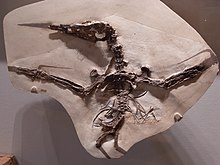Pteranodontoid
| Pteranodontians Temporal range: Early Cretaceous - Late Cretaceous, 127–66 Ma |
|
|---|---|
 |
|
| Mounted skeleton Pteranodon longiceps | |
 |
|
| Fossil specimen of Nyctosaurus gracilis | |
| Scientific classification | |
| Kingdom: | Animalia |
| Phylum: | Chordata |
| Order: | †Pterosauria |
| Suborder: | †Pterodactyloidea |
| Clade: | †Ornithocheiroidea |
| Clade: |
†Pteranodontia Marsh, 1887 |
| Subgroups | |
|
|
| Synonyms | |
|
Euornithocheira Unwin, 2003 |
|
Euornithocheira Unwin, 2003
Pteranodontia is an extinct group of ornithocheiroid pterosaurs that lived from the Early Cretaceous to the Late Cretaceous (middle Barremian to middle Campanian stages) of Asia, Europe, North America and South America.
Pteranodontians, like other pterosaurs, are considered to have been skilled fliers as well as adept at moving on the ground. Evidence from footprints shows that most pterosaurs did not sprawl their limbs to a large degree, as in modern reptiles, but rather held the limbs relatively erect when walking, like dinosaurs. While no pteranodontian footprints are known, it is likely that they also walked erect. Among pterosaurs, pteranodontians had unusually uneven limb proportions, with the forelimbs much longer than the hind limbs. This would likely have required them to use unique modes of locomotion when on the ground compared to other pterosaurs. It is possible that pteranodontians ran (but not walked) bipedally, or that they used a hopping gait. Pterosaur researcher Mike Habib has noted that the limbs proportions of pteranodontians like Anhanguera are consistent with hopping.
Pteranodontians were among the last of the world's pterosaur faunas. The species Piksi barbarulna and a few potential pteranodontids and nyctosaurs have all been found dating from the Campanian to the Maastrichtian ages of the Late Cretaceous period.
Pteranodontia was originally named by O.C. Marsh in 1876. In 2003, it was given a phylogenetic definition by David Unwin as the common ancestor of Pteranodon and Nyctosaurus plus all its descendants. Though Marsh had originally named this group based on the shared absence of teeth in those species, most analyses show that all of the traditional "ornithocheiroid" pterosaurs are also members of this clade.
...
Wikipedia
